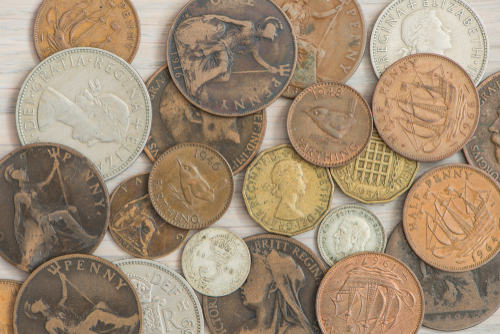
What is LSD?
Have you any interest in LSD? No, I am not talking about the potent psychedelic drug (i.e. acid) that is widely associated with the hippy movement of the 1960s. Rather, I’m referring to the UK’s former imperial (L-s-d) currency system. Did you know that England’s imperial currency system was first introduced during Roman times?
Here is a broad review of the UK’s (imperial) predecimal currency:
In the Beginning
The original currency consisted of silver pennies only. Two hundred and forty pennies weighed one pound in weight. After that, new coins were gradually introduced. This was such that by the 10th century, England had the most sophisticated currency in Europe. The ancient imperial currency system was used throughout the UK until early 1971.
The government ran a two-year lead-up information campaign leading up to the introduction of a new decimalised UK currency in 1971. The date of introduction, i.e. the 15th of February, was dubbed ‘Decimal Day’ or ‘D-day’ by the UK media.
Basic Structure and Denotation
The basic structure of Britain’s old monetary system consisted of pounds (l), shillings (s), and pence (d). The Latin word for ‘pound’ was libra. Thus, the letter “l” was used to denote ‘pounds’, from which the ‘£’ sign was later derived from the capital letter “L”. Similarly, with the Latin words ‘solidus’ and ‘denarius’, meaning shillings and pence, the letters”s” and “d” were used for their respective denotation. Thus, the sum of two pounds, twelve shillings and sixpence could be written as £2-12s-6d, but more commonly, just as £2-12-6. Values of less than £1, would be more simply written, i.e. 12s-6d would be denoted as just 12/6.
A pound was divided into 20 shillings (5p), with the shilling itself being divided into 12 pennies. Thus, a pound (£), was made up of 240 pennies. A penny was further subdivided into two halfpennies or four farthings. The word ‘halfpenny’ was pronounced “hay-pa-nee”, but usually written as “ha’penny”, while the word ‘farthing’ originally meant a ‘fourth part’ in Old English. The farthing ceased to be legal tender in 1960 and the ‘old’ ha’penny in 1969.
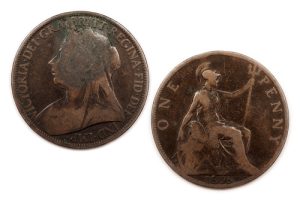
Prior to February 1971, 240 “old” pennies = One pound (£). Image credit: Paul Cullen Photography/Shutterstock.com
Main Denominations
Coins
The denomination of coins still in circulation up until the introduction of decimal currency in 1971, were:
The penny was 1/240th of £1. It was commonly known as a “copper”, the metal from which it was minted.
A threepence coin was termed a ‘threepenny bit’. However, colloquially it was known as “thrippence” or “thruppence”.
The sixpence (6d), was commonly referred to as a “tanner”.
A shilling (1/-), was known as a “bob”.
Formally known as a florin (2/-), the two-shilling coin was known as a “two bob” or a “two bob bit”.
A half-crown coin had a value of two and a half shillings (2/6d).
The crown (5/-), was by the 1960s referred to as “five shillings” or by its nickname of the “dollar”. The coin went out of circulation in 1965. After decimalisation in 1971, a 25p coin was introduced to replace the crown. However, it was only ever issued as a commemorative coin.
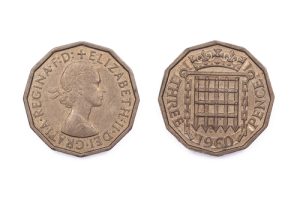
The 12-sided “brass” threepence was introduced in 1937. Image credit: Paul Cullen Photography/Shutterstock.com
Banknotes
Just prior to decimalisation of the UK’s currency in 1971, there were five banknotes in common circulation:
The ten-shilling note was commonly known as “ten bob”. In 1969, a new 50p coin was introduced to replace the 10/- note, which ceased to be legal tender in 1970.
The one-pound note was first issued in 1797, to replace the sovereign. It was printed intermittently up until 1984 when it was replaced by the £1 coin in 1988. The pound’s nickname is the “quid”, which is taken from the Latin phrase “quid pro quo”, which basically translates as ‘something for something’.
A hand-written five-pound note was first introduced to Britain in 1793 due to a gold shortage. It has been in general circulation ever since. Known as a “fiver”, it’s currently the UK’s lowest banknote denomination.
The ten-pound note was first introduced to Britain in 1759 due to a gold shortage. The original notes were only printed on one side. The ten-pound ceased to be legal tender in 1945 and was not re-introduced until 1964. Known as a “tenner”, it’s still one of the four UK banknotes in general circulation.
The twenty-pound note was first introduced to Britain in 1725. The original notes were handwritten. The twenty-pound note ceased to be legal tender in 1945 and was not re-introduced until 1970. Nicknamed a “score”, it’s one of the four UK banknotes in general circulation.
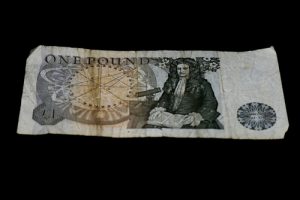
The one-pound note was first issued in 1797. Image credit: Burcu Ergin/Shutterstock.com
Other Denominations
The groat or fourpence was first introduced in England in the 14th century. Nicknamed the joey, it was issued periodically up until the mid-19th century.
The guinea coin was in general circulation in Britain between 1663 and 1816. Containing a quarter of an ounce of gold, it was originally valued at 20 shillings i.e. one pound. Its name came about due to the fact much of the gold used to mint the coin was sourced in Guinea, West Africa. The guinea’s value tended to float in line with the price of gold but from 1717, its value was officially fixed at 21 shillings. From 1816 onwards, a few things; e.g. artwork, professional fees, racehorses, etc., have been traditionally priced in guineas.
The sovereign was a gold coin first minted in the late 15th century. Valued at one pound (£1), a newly issued sovereign coin replaced the guinea in 1817. It was in general circulation until 1914 but has been issued periodically as a commemorative coin ever since.
The first fifty-pound notes were hand-written and initially introduced to Britain in 1725. They were then issued periodically until 1945 when they were withdrawn from circulation. The £50 banknote was reintroduced to the UK in 1980.
Do you know?
Do you know that there are only two countries in the world that still operate non-decimal currencies? These are Mauritania and Madagascar.
Header image credit: Mark Anthony Ray/Shutterstock.com


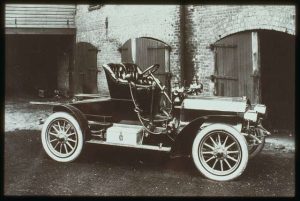



[…] 50p coin was first introduced as part of the UK’s then imperial currency system on 14 October 1969. The revolutionary design saw it become the world’s first seven-sided […]